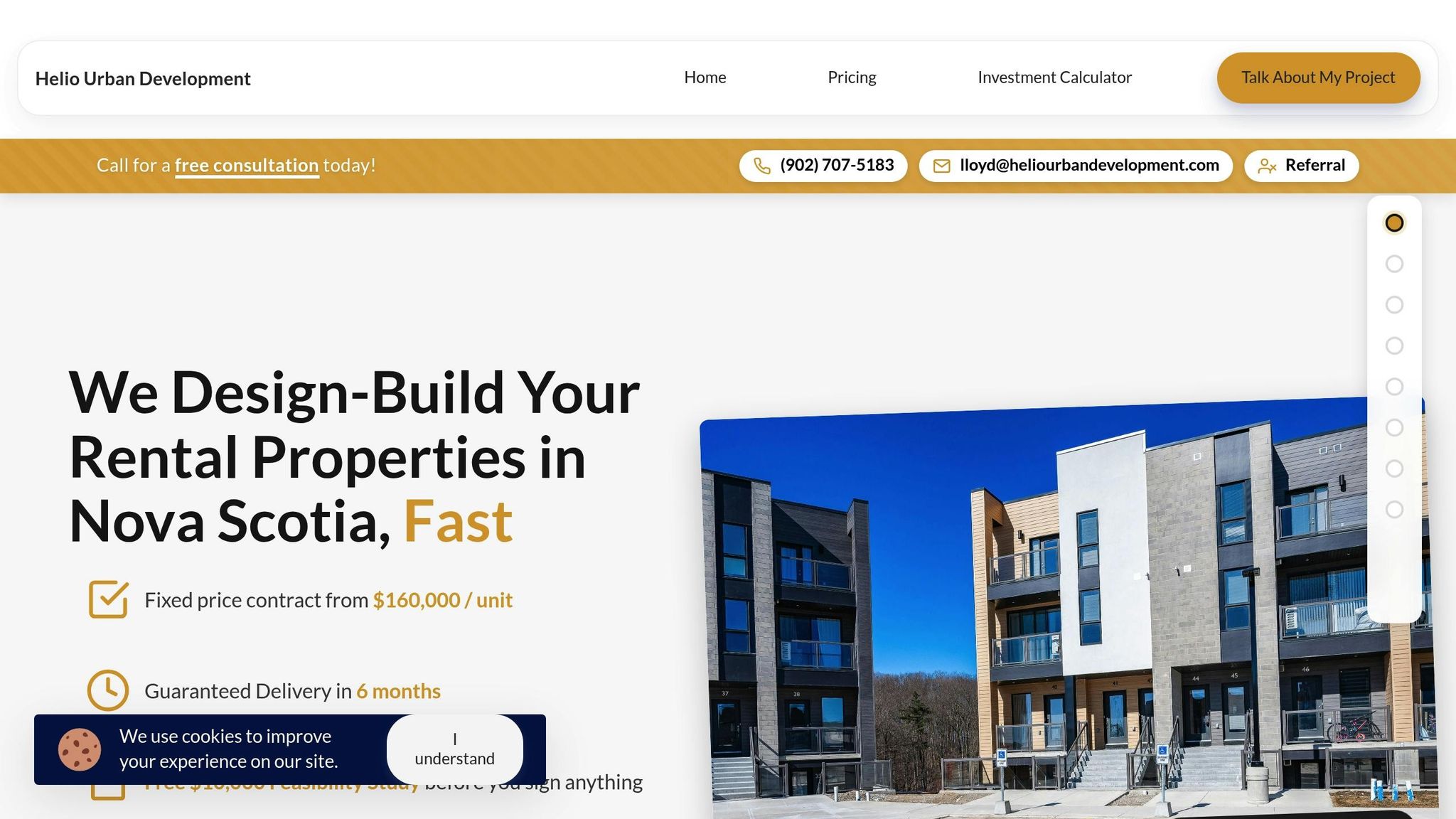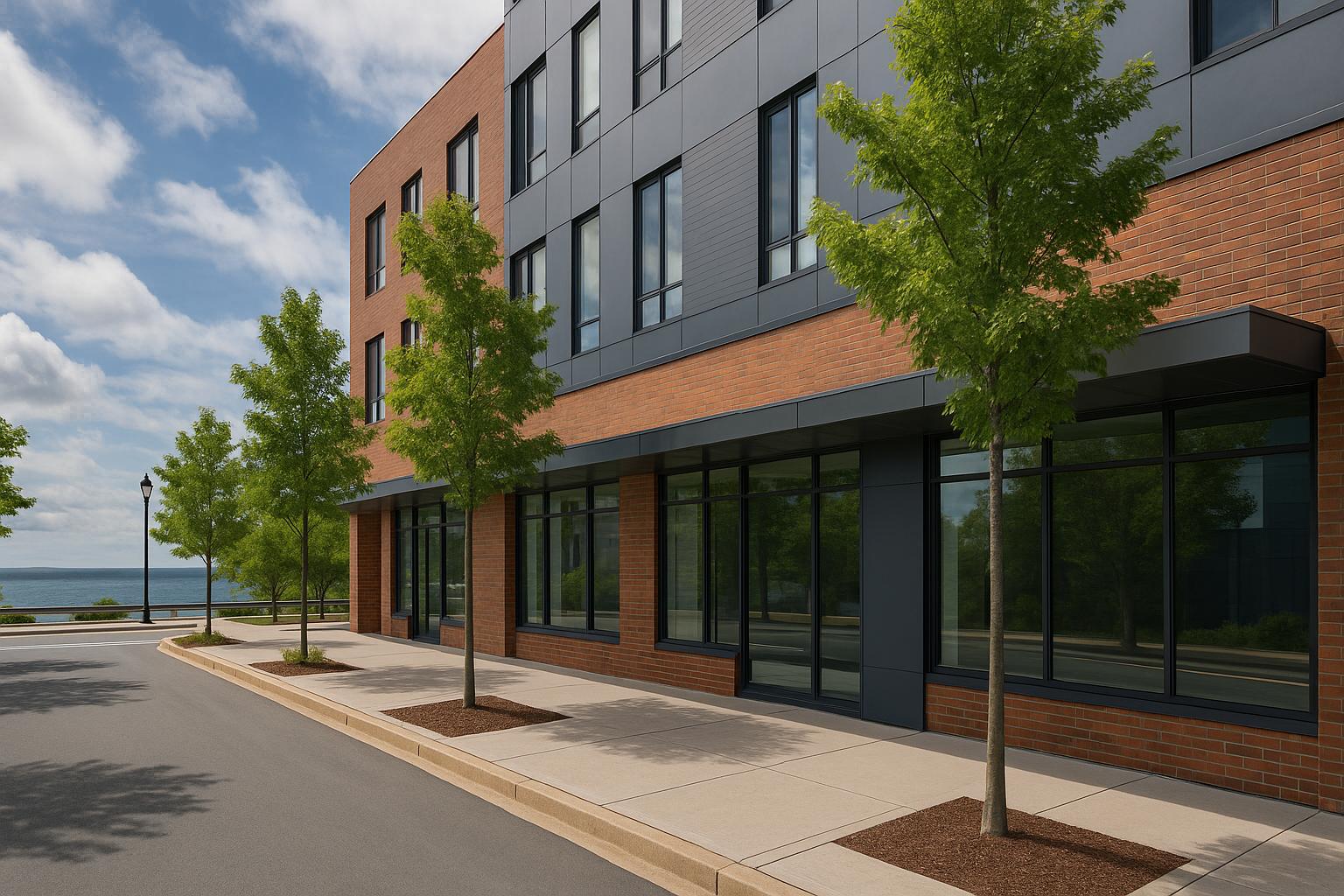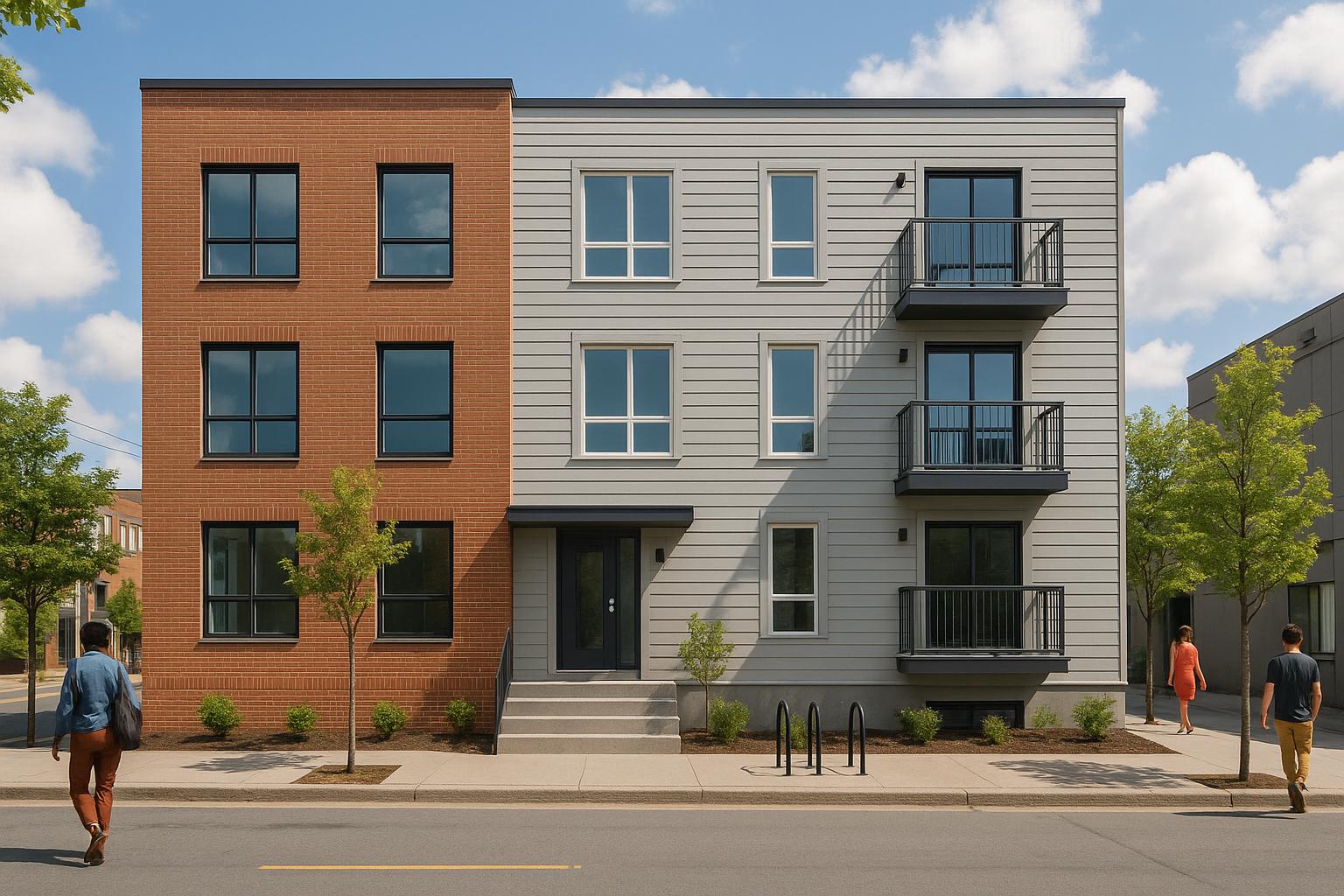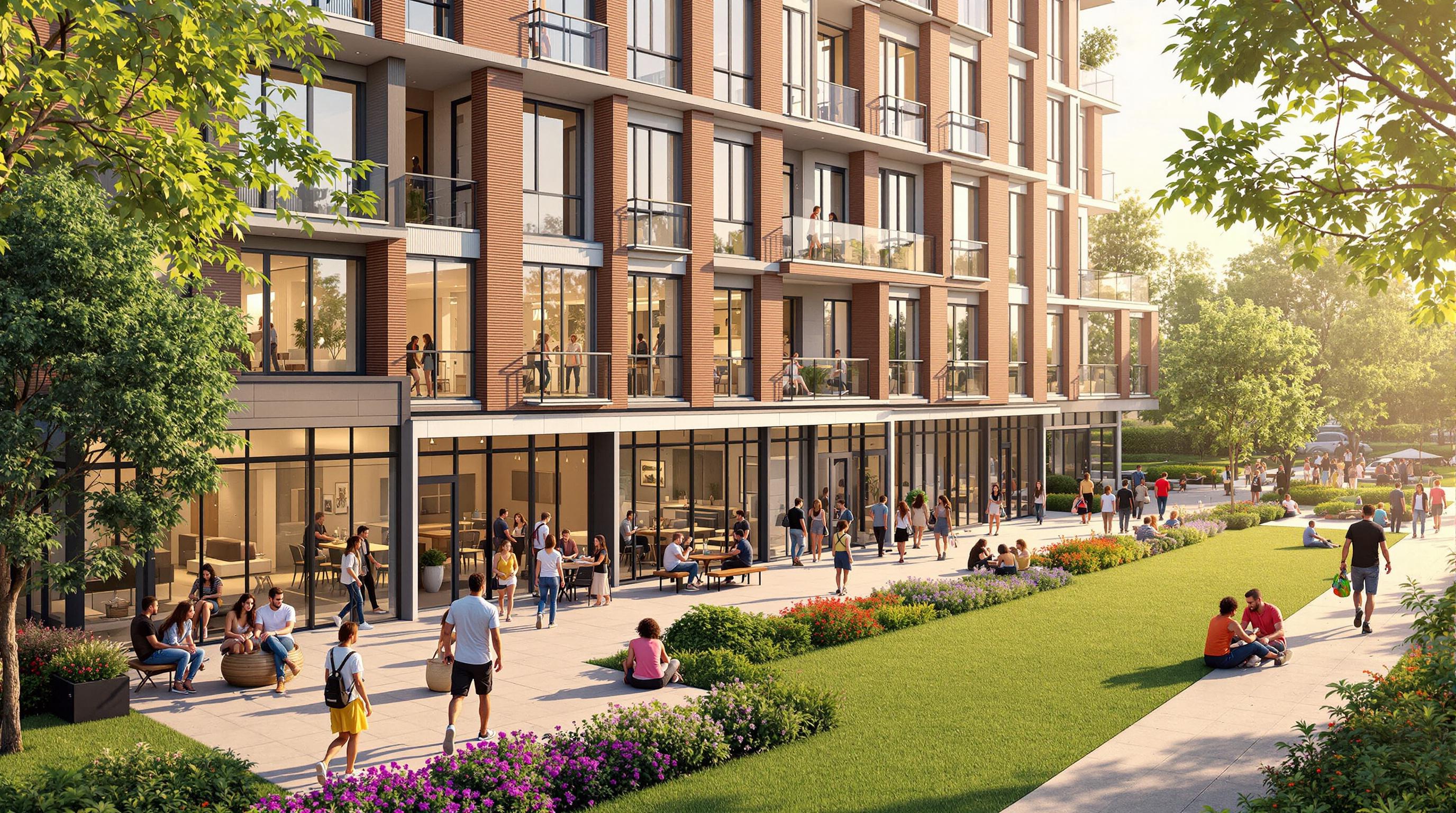Balancing retail-friendly storefronts with back-of-house necessities like loading zones and utility access is a major challenge in mixed-use developments, especially in Nova Scotia. Poor planning often leads to blocked customer parking, unsightly utility equipment, and disruptions that hurt retail performance. These issues can also increase tenant turnover, delay construction, and inflate costs.
Key takeaway: Integrated design is the solution. By coordinating utilities, service corridors, and retail spaces from the start, developers can avoid conflicts, reduce costs, and improve tenant satisfaction. Companies like Helio Urban Development demonstrate how unified planning, fixed pricing, and efficient timelines can create retail-friendly spaces while addressing operational needs.
Quick insights:
- Fragmented planning often disrupts retail environments.
- Poorly placed loading zones and visible utilities deter customers.
- Integrated design ensures all systems work together smoothly.
- Fixed-price contracts and guaranteed timelines reduce financial risks.
For property owners, the choice is clear: invest in integrated solutions or risk costly inefficiencies and tenant dissatisfaction.
Mixed Use: Building in Flexibility in a Chaotic Environment
Problems with Standard COR Servicing Methods
Traditional approaches to servicing commercial, office, and retail (COR) spaces often handle design and construction elements in isolation. This fragmented approach leads to a cascade of challenges that impact operational efficiency, tenant satisfaction, and financial outcomes.
Disconnected Planning and Coordination Problems
When architects, engineers, and contractors work independently, the results can be chaotic. For example, utility risers might block storefront views, loading zones might interfere with customer parking, and service access points could end up in highly visible - and undesirable - locations.
Picture this: an electrical contractor runs conduits along a feature wall meant to enhance the shopping experience, or a plumbing contractor installs pipes in what could have been prime display space. These missteps are more than aesthetic issues; they create functional problems. A poorly placed loading zone, for instance, can block customer access during peak hours, leaving property owners juggling complaints from tenants and trades while tenants lose business.
These coordination issues become even more pronounced in Nova Scotia's harsh winters. Snow removal equipment might not have the access it needs, disrupting loading operations. Similarly, heating system maintenance can require utility access that clashes with storefront designs, creating ongoing frustrations for tenants and property owners alike.
Ultimately, these design misalignments disrupt operations and diminish tenant experiences.
Negative Effects on Tenants and Customers
Poor integration of service areas can directly harm retail performance. Customers are less likely to visit stores when delivery trucks block access or clutter the view, even if these disruptions are temporary. Seeing dumpsters, utility equipment, or delivery vehicles near a retail entrance creates a negative impression that deters foot traffic.
For retail tenants, these disruptions translate into operational headaches. Imagine a restaurant unable to serve customers because garbage collection is scheduled during lunch hours, or maintenance work blocks patio seating. These small interruptions can snowball into significant revenue losses over time.
Office tenants face their own challenges. Service corridors running past conference rooms can disrupt meetings with noise from deliveries or maintenance activities. Poor utility planning might cause unreliable internet or inconsistent heating and cooling, directly affecting productivity and tenant satisfaction.
The visual impact is another major issue. Utility meters, electrical panels, and other service equipment scattered across street-facing walls create an unattractive, industrial look. This visual clutter doesn't just hurt the property’s appearance - it actively drives customers away, forcing retail tenants to compete not only with other businesses but also with poor planning decisions.
These operational and aesthetic problems often lead to financial consequences for property owners.
Financial Risks for Property Owners
Disjointed coordination during construction results in costly delays and change orders. For instance, if electrical work is held up because the HVAC contractor needs the same wall space, the entire project can grind to a halt. Retail tenants may delay their openings, office tenants might extend temporary leases elsewhere, and property owners lose valuable rental income.
Fragmented oversight leads to inconsistencies in quality. A loading zone might meet engineering standards but fail to address tenant needs. Similarly, utility access might comply with codes but create maintenance headaches down the line. Each contractor focuses on their specific task, often ignoring how their work impacts the building as a whole.
These issues also drive up long-term operational costs. Inefficient utility layouts can increase energy expenses, poorly planned loading zones can require constant traffic management, and inadequate service access can lead to higher maintenance costs. Property owners are left dealing with problems that could have been avoided with better planning.
The financial fallout doesn’t stop there. Tenant turnover rises when retail spaces underperform due to operational challenges. Longer vacancy periods become the norm as prospective tenants spot these issues and look elsewhere. Lease rates may drop when competing properties offer better-integrated solutions.
Insurance and liability risks also increase when responsibilities are split among multiple contractors. Property owners face higher premiums and greater exposure to safety hazards or system failures. And with traditional construction’s cost-plus approach, these risks are often borne by the property owner - not the contractors responsible for creating them.
Integrated Methods for Better COR Servicing
Tackling the challenges of COR servicing starts with integrated planning. By aligning utilities, loading zones, and retail spaces from the very beginning of a project, you can ensure all systems work together smoothly rather than competing for space and resources. Below, we explore how this approach can turn potential obstacles into practical advantages.
Combining Service Corridors and Access Points
Shared service corridors streamline operations while keeping disruptions to retail spaces at a minimum. Instead of scattering utility access points all over the building, an integrated design centralizes these elements into dedicated pathways, keeping service activities out of sight and away from customer-facing areas.
These corridors can house electrical panels, plumbing risers, HVAC equipment, and telecommunications infrastructure in a single, concealed pathway. This setup not only reduces the space needed for utilities but also frees up more room for retail purposes. On top of that, it minimizes the inconvenience caused by maintenance work.
To ensure long-term functionality, these corridors should be designed with maintenance needs in mind. For instance, they should be wide enough for equipment replacement, include proper lighting and ventilation, and connect directly to loading docks and mechanical rooms - avoiding retail zones altogether.
Nova Scotia’s seasonal challenges also come into play. Features like designated areas for snow removal equipment, systems for managing winter maintenance, and access points designed for harsh weather can help keep retail areas undisturbed during the colder months.
Hiding Back-of-House Functions
The back-of-house elements of a building - necessary but often unsightly - don’t have to be an eyesore. With thoughtful design, they can blend into the overall retail environment and even enhance it.
Architectural solutions like custom millwork can conceal electrical panels while adding storage, and decorative screens can hide HVAC equipment without affecting airflow. Loading zones, too, can be designed to minimize their visual impact by incorporating recessed bays or weather-protective overhead structures.
For a cleaner and more streamlined look, underground utility routing is a highly effective option. By running electrical, plumbing, and telecommunications systems beneath retail spaces, you eliminate visual clutter entirely. This approach works especially well in new builds, where excavation can be planned from the outset.
That said, concealing these functions doesn’t mean making them hard to access. Modern designs include discreet access panels that blend seamlessly with architectural finishes, keeping utilities easy to service while maintaining a polished appearance.
The benefits go beyond aesthetics. Properties with well-integrated back-of-house designs often command higher retail rents, as tenants can focus their budgets on enhancing customer-facing areas rather than hiding infrastructure. However, maintaining this balance requires careful scheduling to ensure retail operations remain unaffected.
Using Smart Scheduling and Flexible Design
Smart scheduling is key to coordinating building services - like deliveries, maintenance, and cleaning - without disrupting retail operations. For example, deliveries can be scheduled outside peak shopping hours, keeping loading zones clear during busy times and improving the overall experience for customers.
Flexibility in design is equally important. Modular utility systems make it easier to reconfigure retail spaces as tenant needs change, while movable walls allow for quick adjustments between retail and storage areas. Similarly, adaptable electrical and data systems can support a variety of retail setups without requiring costly rewiring.
Advanced scheduling systems take this a step further by planning maintenance activities - like HVAC servicing or plumbing inspections - during off-peak times. Seasonal scheduling is particularly crucial in Nova Scotia, where heating systems should be serviced in the summer and preparations for winter weather handled in the colder months.
Emergency planning also plays a role. By having procedures in place for utility shutoffs, system tests, and emergency repairs, property managers can address issues quickly, keeping retail spaces operational even during unexpected events. Smart building systems with real-time monitoring and alerts can further enhance this process, ensuring that all building services work together seamlessly.
Case Study: Helio Urban Development's Integrated Approach

Helio Urban Development has found a way to blend operational efficiency with customer-focused design, proving that a unified strategy can lead to real, measurable results. By tackling the challenges of COR (common operational requirements) servicing with a design-build methodology, the company has redefined how projects are handled. Founded by Lloyd Liu, a former Merrill Lynch investment banker, and Yuan He, a data scientist from the University of Pennsylvania, Helio was born out of their frustrations with the inefficiencies of traditional construction methods. Their approach brings together all key functions into one streamlined process, ensuring smoother designs and more predictable outcomes.
Systematic Design-Build Methodology
Rather than outsourcing various professionals and managing them under separate contracts, Helio brings everyone - planners, architects, engineers, and construction experts - together under one roof. This eliminates the blame game and coordination headaches that often lead to unnecessary costs, which can run as high as $47,000 per project.
Take their mixed-use developments as an example. From the outset, Helio's team integrates service corridors, utility access, and loading zones into the design. With input from Yuan He, who developed advanced scheduling optimization systems, potential delays and conflicts are minimized. For instance, HVAC systems are routed along pre-planned paths that avoid retail areas, and electrical panels are neatly incorporated into dedicated service corridors.
To ensure quality, Helio embeds multiple layers of oversight into the process. A Professional Engineer conducts five inspections during construction, and property owners choose the final inspector. This triple-check system ensures that COR servicing meets both functional needs and aesthetic goals.
Fixed Price and Timeline Guarantees
Helio’s integrated process naturally supports strict controls over budgets and timelines. The company offers a fixed price of $160,000 per unit and guarantees project completion within six months. If delays occur, penalties of up to $1,000 per day are enforced. This is a significant improvement over traditional cost-plus construction, where overruns of 30–60% are common and often force compromises on essential elements like service corridors or concealed building systems.
The six-month timeline is particularly valuable for mixed-use developments, where delays can disrupt retail operations. While conventional projects might take twice as long, Helio’s approach not only cuts construction time in half but also protects property owners from potential losses of up to $8,800 per month in rental income.
For those seeking CMHC MLI Select financing, Helio offers a $200,000 per unit option designed to meet energy efficiency requirements. This allows for 95% financing with just a 5% down payment and a 50-year amortization period. This financing flexibility makes it easier for owners to invest in proper COR servicing without straining their budgets.
Results: Retail-Friendly Mixed-Use Success
Helio’s results are hard to argue with. Currently, 31 units are under construction, with 131 more in the planning stages across Nova Scotia. Completed projects have had zero cost overruns, and their integrated approach ensures retail spaces retain their premium appeal. Meanwhile, residential units fetch rents of $1,950–2,100 per month, showcasing how a well-thought-out process benefits both retail and residential components.
Transparency is another hallmark of Helio’s approach. Daily photo updates allow property owners and prospective retail tenants to track progress in real time. Additionally, a two-year warranty on all construction work ensures that any issues with COR servicing are resolved quickly and effectively.
Co-founder Lloyd Liu personally guarantees project timelines, underscoring the company’s commitment to accountability:
"I personally guarantee every timeline because I've felt the pain of construction delays."
This level of dedication has helped property owners achieve annual returns of 12–20%, highlighting the effectiveness of Helio’s integrated, retail-friendly strategy.
sbb-itb-16b8a48
Practical Advice for Nova Scotia Property Owners
Successfully managing COR servicing in mixed-use developments requires careful planning and skilled execution. When done right, property owners can benefit from happier tenants, steady rental income, and fewer operational headaches.
These strategies build on earlier discussions about integrated design principles, ensuring smooth COR servicing that supports both retail and office spaces.
Choosing the Right Construction Partner
Mixed-use projects thrive when you work with a construction partner who offers integrated design and build services. Without this unified approach, fragmented planning can disrupt retail and service areas, leading to costly inefficiencies.
Seek out builders who handle design, engineering, and construction under one roof. This streamlined process ensures that service corridors and utility access points are thoughtfully planned from the start, saving time and avoiding coordination issues.
Fixed pricing and timeline guarantees are non-negotiable for mixed-use developments. Cost-plus models can lead to budget overruns, forcing compromises on critical features like concealed utility routing or well-designed loading zones.
Insist on triple-layer quality checks with multiple inspections throughout the construction process. For instance, a Professional Engineer should conduct at least five inspections, and as the property owner, you should have the final say on the last inspection. This ensures COR servicing meets both functional and aesthetic standards, which are essential for maintaining retail appeal.
Additionally, daily photo updates and real-time progress tracking can help you identify potential problems early and keep retail tenants informed. This cohesive approach sets the stage for operational and retail success.
Best Practices for Maintaining Retail Success
Keeping retail spaces vibrant requires smart operational planning. Coordinating delivery schedules and structuring loading and service times can help manage traffic during peak hours and limit disruptions. For example, scheduling service activities during off-peak times and placing utility access points away from customer areas can significantly improve the shopping experience.
Efficient inventory management also plays a role. Reducing the frequency and duration of deliveries minimizes the time service vehicles occupy loading zones. Well-designed service corridors and utility access points that remain out of public view can prevent costly retrofits down the line. Including lease provisions to coordinate delivery and service schedules can further ease conflicts between retail and residential tenants[1].
Operational strategies are just one piece of the puzzle - local knowledge is equally important.
Using Local Knowledge and Standards
Local expertise is crucial when designing COR servicing solutions in Nova Scotia. Zoning requirements and planning policies vary across the province, so what works in Halifax may not suit smaller communities like Antigonish or Bridgewater. Partnering with a team familiar with areas within a 90-minute radius of Halifax ensures compliance with regional standards, including considerations like snow loads, coastal winds, and zoning rules.
For energy-efficient mixed-use developments, understanding programs like CMHC MLI Select is key. Builders experienced with these requirements can help you secure up to 95% financing with as little as a 5% down payment, all while ensuring COR servicing meets energy efficiency standards.
Collaborating with property management companies that know Nova Scotia’s rental market can also make a difference. Tailoring your operations to local tenant expectations is essential - for example, Nova Scotia renters increasingly look for features like in-unit laundry and smart home technology. Retail tenants, on the other hand, need dependable utility access and flexible delivery options. By working with construction professionals who combine efficient delivery methods with deep local expertise, you can set your mixed-use development up for success in Nova Scotia’s unique market conditions.
Conclusion: Finding Balance in Mixed-Use Developments
Blending COR servicing with back-of-house functions requires a well-coordinated and unified planning process. The typical fragmented approach in construction - where contractors operate in silos - often leads to visible utilities, poorly positioned loading zones, and disruptions that repel customers, all of which can undermine retail environments.
The contrast between disjointed construction and guaranteed results is especially stark in mixed-use projects. Relying on traditional cost-plus models and uncoordinated planning often results in budget overruns of 30-60% and project delays that extend timelines from 8 months to over 18 months. These delays not only inflate costs but also postpone tenant openings and reduce foot traffic, creating a ripple effect that impacts profitability. This underscores the need for a streamlined, solution-oriented approach.
Integrated design-build methods offer a clear path forward. By aligning planners, architects, and engineers from the outset, these methodologies eliminate financial uncertainty with fixed-price contracts and on-time delivery. This collaborative approach ensures that service corridors, utility access points, and loading zones are strategically designed from day one.
Projects in Nova Scotia have shown how integrated servicing can drive tenant retention, increase retail sales, and enhance property values. In a competitive market, these benefits are essential for properties aiming to stand out with well-thought-out servicing systems.
For property owners venturing into mixed-use developments, the choice is straightforward: partner with construction teams that provide integrated solutions and fixed-price guarantees, or face the challenges of fragmented planning, operational disruptions, and escalating costs. The success of your retail spaces - and the profitability of your development - hinges on getting servicing integration right from the beginning.
As highlighted earlier, elements like smart scheduling and concealed utilities form the backbone of thriving mixed-use properties. When these components work in harmony, retail tenants can focus on serving customers, residents enjoy high-quality living spaces, and property owners benefit from consistent income and solid returns.
FAQs
How does integrated design enhance tenant satisfaction and lower costs in mixed-use developments?
Integrated design plays a key role in boosting tenant satisfaction by crafting spaces that are both well-organized and community-focused. By addressing diverse needs, it creates an inviting atmosphere that encourages tenants to stay longer and feel more connected to their environment.
On top of that, integrated design helps cut costs by streamlining infrastructure and operational systems like shared utilities and maintenance. This approach not only brings down long-term expenses but also increases efficiency, making mixed-use developments more practical and financially rewarding.
What challenges do traditional COR servicing methods pose in mixed-use developments, and how can they be addressed?
Challenges in Traditional COR Servicing
Managing Commercial, Office, and Retail (COR) spaces in mixed-use developments often comes with its own set of headaches. Common issues include poor communication, inefficient use of available space, and delays in utilities or loading zone operations. These problems can throw a wrench in retail operations, lowering foot traffic and leaving tenants dissatisfied. And when tenant satisfaction dips, so does profitability.
So, how do you tackle these challenges? The answer lies in adopting an integrated, single-accountability approach. This method helps streamline operations, making better use of space and reducing disruptions to retail activities. On top of that, proactive maintenance and smart design solutions can make a world of difference. They not only improve how everything functions but also create a better experience for tenants and ensure a steady flow of customers. It’s all about striking the right balance between retail needs and behind-the-scenes operations.
How does Helio Urban Development streamline COR servicing to benefit property owners in mixed-use projects?
Helio Urban Development streamlines COR (Commercial, Office, Retail) servicing through an integrated design-build process. This method unites planners, architects, engineers, and construction teams right from the beginning, promoting seamless collaboration and reducing the risk of delays or unexpected expenses.
For property owners, this translates to faster project turnarounds - often completed within six months - and firm timelines backed by financial penalties for any delays. By maximizing space and ensuring efficient servicing, Helio helps property owners boost retail foot traffic, increase rental revenue, and improve property value, all while addressing the distinct challenges of mixed-use developments across Canada.



